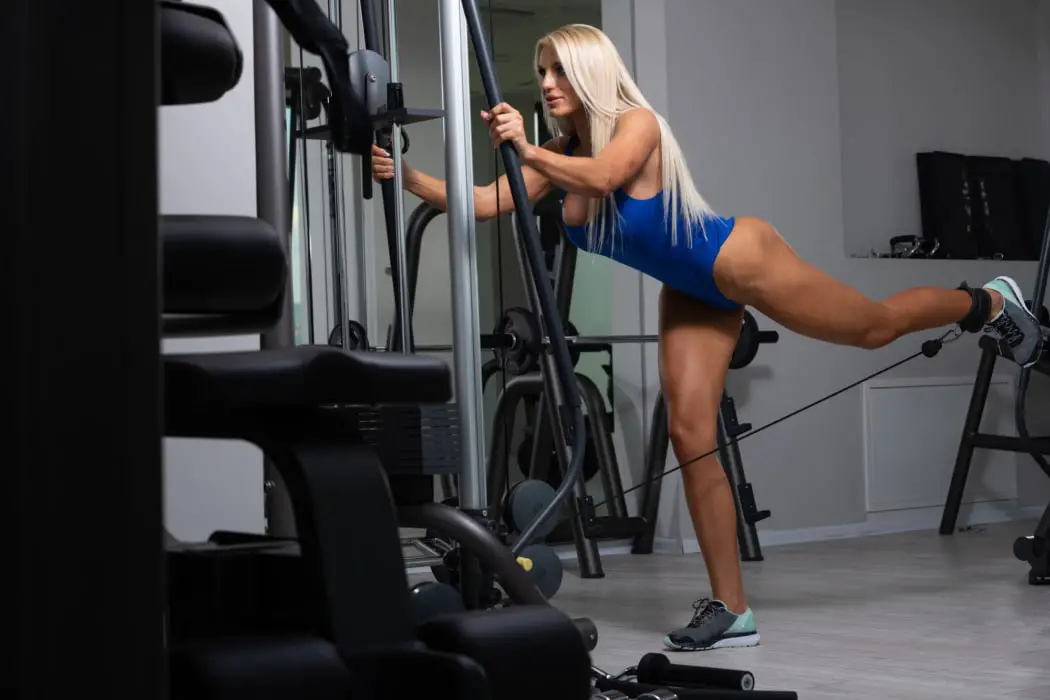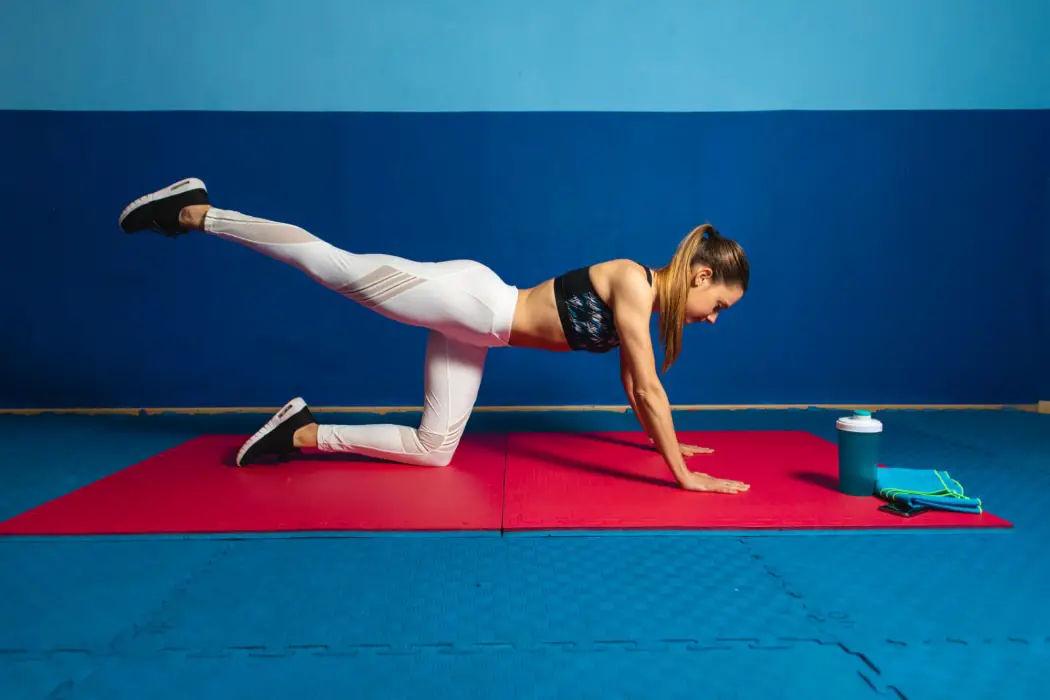Glute Kickbacks are one of the primary glute isolation exercises fitness enthusiasts and bodybuilders use to enhance their buttocks. The exercise is primarily done using the cable machine in gyms. However, there are certain home variations that can isolate the gluteal muscles in the same pattern of movement as well.
Overall, glute kickbacks are targeted at increasing gluteal development. Aside from the obvious aesthetic bodybuilding purposes of the exercise, it also greatly enhances your compound lower body exercise performance.
What Muscles Do Glute Kickbacks Work?

The targeted muscles:
- gluteus maximus
- gluteus medius
- gluteus minimus
Stabilizers:
- hamstrings
- calves
- core
The targeted glute muscles take up the full force of the movement. The stabilizers serve as auxiliary muscles to keep the body stable and powerful.
Cable kickbacks and their variations are all highly effective in targeting booty muscles and building toned and stronger glutes.
By engaging all three booty muscles, the kickbacks result in a well-rounded (pun intended) development of the tush area.
The gluteus maximus is the biggest and the strongest muscle of the butt and the whole body. It covers a significant portion of the hip area. This is the uttermost muscle of the glute muscles and is responsible for the general shape of your booty. Its primary function is to straighten the leg at the hip. “The lower part of the muscle also acts as an adductor and external rotator of the limb. The upper fibers act as abductors of the hip joints.”
The gluteus medius is the second in size muscle in the group. It is located on the outer surface of the pelvis, making up the upper outer parts of the booty shape. Gluteus medius is responsible for the internal and external rotation of the hip and its abduction.
The gluteus minimus is the smallest and the most hidden part of the gluteal muscles – it is situated beneath the gluteus medius. The Gluteus minimus is mainly a hip stabilizer and abductor of the hip.
Glute Bridge Exercises for a Firm Peach
What Are the Glute Kickback Benefits?
By isolating the glutes and working all three of the muscles, glute kickbacks provide several performance and aesthetic benefits.
The first of the list is the most obvious (an important for many) benefit – a round and toned booty. Glute kickbacks are often used to enhance the shape of one’s buttocks. And by isolating them specifically, the exercise is highly effective.
However, aside from growing glutes, the kickbacks heighten their strength. Which, in its turn, comes with several performance benefits. Firstly, glute kickbacks power up your standard compound lower body exercises like squats, romanian deadlifts, lunges, etc. Secondly, the kickbacks provide a powerful and stabilized base for explosive movements like jumps, running, kicks, and so on.
How to Do Glute Kickbacks?

Let’s take a look at the standard cable machine glute kickbacks done in gyms with proper equipment.
- Set up the cable machine: adjust resistance, attach an ankle strap to the lowest pulley.
- Stand facing the pulley and attach the strap to your intended working leg.
- Take hold of the stand and slightly tilt your torso forward. This will enhance glute activation. Keep your torso at around 45 degrees.
- Brace your core, bend your knees, and push your working leg back.
- Squeeze your glutes at the top of the movement and lower your leg back to the starting position.
- As you finish your reps, switch the ankle cuff attachment to the other leg.
Remember to keep the movement controlled. Slower movements without relying on momentum will activate your gluteus muscles better and provide mind-muscle connection.
What NOT to Do:
- Proper form is important! Do not overarch your back at the top of the movement. Your lower should be stable and fixed – glutes do all the work.
- Do not keep your toes pointed to the ground. While this placement is not harmful per se, an externally rotated foot provide much better glute engagement.
How to Get Bigger Hips at Home
What Are Glute Kickback Variations?

Several glute kickbacks variations can be done in the gym and at home. Plus, there are a few “no equipment” options.
The cable machine glute kickbacks we’ve covered also have a couple of variations, including:
- 90-degree angle glute kickbacks (hinge your torso to be parallel to the floor)
- an elevated kickback exercise (the “standing leg” placed on a box or a bench)
Another gym option is an actual glute kickback machine. It has a dedicated footplate that you push instead of pulling the cable. The machine is excellent for working with heavier weights as it adds more stability. However, one downside to it is that it doesn’t fit all body types.
Donkey kicks. This one is mainly the home version of kickbacks. Sometimes, the names are used interchangeably, but the exercise looks different. They can be done with a resistance band or simply bodyweight.
How to Do Donkey Kickbacks:
Stand on all fours on an exercise mat. Raise the right leg up in its bent position (straightening the leg will lead to more hamstring activation). Squeeze your glutes at the top of the movement and lower the leg to the floor. Remember not to make a common mistake – arching your back. For added resistance, place a bend over your knees.
The second home-friendly variation is the standing banded kickback. If you have no opportunity to use cables or a dedicated machine, you can still replicate the movement at home with this variation.
How to Do:
Stand with feet shoulder-width apart, and place a resistance band slightly higher than your knees. Find a wall or another surface to take hold of for better stability. Tilt your torso to 45 degrees and bring your leg backward like the cable glute kickback.
How Long Does It Take for Your Butt to Grow?
In Conclusion
Glute kickbacks and their variations are all a must-do effective exercise for developing a strong and round booty. It will become a great addition to any leg day, especially the one aimed at the posterior chain.
Glute cable kickback is one of the few glutes isolation exercises that target all three major muscles of the booty. They should not be used as a substitute for compound lower body exercises but used alongside them for optimal results.
And while we typically think of it as a gym exercise, it can be replicated at home with minimal equipment and even as a simple bodyweight exercise. If you are interested in more glute exercises to do at home, check my previous article.
Are you planning to add any glute kickback variation to your low body days, or do you prefer other glute isolation exercises? Share your thoughts and alternative exercises in the comments section!
 Fact checked by
Fact checked by